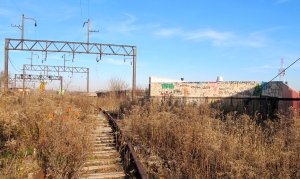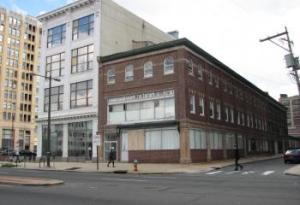November 23, 2010
Theater Review | ‘In the Footprint’
A Brooklyn Civics Lesson, Offered in Word and Song
By CHARLES ISHERWOOD
Published: November 23, 2010
As subjects for musical comedy go, it would be hard to fathom anything less promising than the legal intricacies of the concept of eminent domain. Or, for that matter, the socioeconomic diversity of the crazy quilt of Brooklyn neighborhoods. The great Stephen Sondheim himself might find it tricky work to make lyrical magic of the relationships among the various civic entities charged with approving land-use deals in New York City.
Yet these matters are rhapsodized in song with style and wit in the spirited new show from the Civilians, “In the Footprint: The Battle Over Atlantic Yards,” which opened on Monday night at the Irondale Arts Center in Fort Greene, Brooklyn, within a demolition ball’s swing of the site in contention.
The title may sound like a dissertation submitted by a budding sociologist — subtitles are not too inviting on a theater marquee — but don’t let that deter you. This simple, scruffy-looking but smartly put-together production, written and directed by Steve Cosson and featuring songs by Michael Friedman (“Bloody Bloody Andrew Jackson”), is as fresh, inventive and frankly as entertaining as any new work of musical theater to open this fall. (No, this isn’t saying all that much, but never mind.)
The Civilians have employed the company’s traditional modus operandi in assembling this collage of fact, opinion and passionate feeling concerning the drawn-out conflict over the redevelopment of the Vanderbilt Yards near downtown Brooklyn. (Not in downtown Brooklyn, as one of the aggrieved residents makes clear.) The text of the show is drawn from the company’s two years of research.
Mr. Friedman’s deft, cabaret-style songs are often original — people do not speak in lyrics, after all — but Mr. Cosson’s text consists exclusively of verbatim testimony. Some of it comes from public statements from the city officials and business executives with a master plan to remake the site as a grand urban mini-metropolis surrounding a gleaming new basketball arena. The rest is culled from interviews with the smaller fry who mustered a contentious public protest at what they saw as an ugly, bulging blight on the surrounding neighborhoods.
It is not hard to discern where the sympathies of the show’s creators ultimately lie. Marty Markowitz, the Brooklyn borough president who was an early and enthusiastic supporter of the multibillion-dollar redevelopment proposal, is depicted as a yapping basketball. Frank Gehry, the renowned architect whose signature pencil-shaving design for the arena is represented by a twirling disco ball, is heard pontificating fatuously about his “iconic” buildings in Spain and Los Angeles and the tower he refers to as “Miss Brooklyn,” one of more than a dozen in the original plans.
As for Bruce Ratner, the prominent developer behind the project — let’s just say that should anyone offer Mr. Ratner a pair of tickets to the show, he would be wise to decline. Mr. Ratner might be marginally more welcome at a Nets game in New Jersey this season. (The development plan hinged, you’ll recall, on relocating that basketball team to Brooklyn.)
But “In the Footprint” does not dramatize its subject matter as a simple David and Goliath story (albeit one with a different ending). The voices of a wide spectrum of interested parties are included, with the cast of characters ranging from boldface names like Michael R. Bloomberg and Jay-Z and Jonathan Lethem, to the community leaders on both sides of the controversy, to the neighborhood dwellers whose houses and livelihoods are at stake.
From the Babel of contrasting opinions and arguments emerges an edifying if not always cheering lesson in the way that cities and cultures evolve, and the way the balance of power between the mighty brokers of New York and its unmonied citizens does not. “In the Footprint” also illuminates how the changing demographics of the neighborhood have informed (and inflamed) the relationships between the black and white populations and how the redevelopment plan sowed division among the area’s black residents.
This may make the show sound like a civics class with songs in place of pop quizzes, which in some sense it is. But this seminar is delivered not by a droning lecturer but by a chorus of distinctive voices: impassioned, cynical, outraged, aggrieved, but always bristling with personality. New Yorkers to the core, in other words.
The particularity of each is captured with vivid precision by a terrific cast of six. Colleen Werthmann, a Civilians veteran, is memorable as the feisty Patti Hagan, half of a politically engaged sister act who personally went door to door to conduct an informal census proving that more than 800 people lived within the “footprint” of the planned development, not the 100 Mr. Ratner had blithely estimated. Greg McFadden portrays the determined Daniel Goldstein, one of the last holdouts among those eventually bought out by the developers, who is nudged into advocacy unwillingly and offers the startling news that “no elected official ever voted” on the plan.
Donnetta Lavinia Grays burns with righteous indignation as Bertha Lewis, a community leader who staunchly supported the project, delivering a fiery tirade against the “gentrifiers” who oppose it. She is the temperamental opposite of Simone Moore’s Brooklyn city councilwoman, Tish James, who fights the plan with an air of reasoned, implacable rectitude.
As Ken Fisher, a longstanding Brooklyn councilman, Matthew Dellapina delivers one of Mr. Friedman’s funniest songs, in which the borough is sliced up into four demographic sectors, but not the ones you’d expect. One — the more upscale neighborhoods stretching between Greenpoint and Red Hook — he simply calls “Manhattan.”
Billy Eugene Jones dances nimbly among his various roles, which range from the soberly supportive local figure James Caldwell, who calls Mr. Ratner “an angel sent from heaven,” to an elderly security guard who refuses to give his opinion on any of these matters unless the interviewers pony up some cash. “Not-for-profit?” he asks skeptically. “What that mean?”
The songs, mostly solos, serve as connective tissue, lightening the mood and providing a nice contrast in texture to the talking-head testimonials. But they, too, are information-packed, wry little tone poems made of found materials, setting arcane data to sprightly melodies played by the music director Kris Kukul.
“In the Footprint,” with its informal, bare-bones presentation and almost improvisational air, does not really rely on any of the traditional blandishments of musical theater. There is nothing resembling a fully staged or choreographed musical number, and no soaring songs about chasing your dreams or finding that one true love. (I don’t want to mislead lovers of old-school Broadway musicals, or, perhaps more pertinently, scare away civic-minded people allergic to them.)
But there is a chorus on hand, at least briefly. This being Brooklyn, it is an assembly of bloggers, all with firm opinions on the matters at hand. Which does not mean that they can be bothered to get out of their bathrobes.
IN THE FOOTPRINT
The Battle Over Atlantic Yards
Written and directed by Steve Cosson; music and lyrics by Michael Friedman; sets by Andromache Chalfant; costumes by Chloe Chapin; lighting by Lucrecia Briceño; sound by Shane Rettig; video and projections by Jeanette Yew; music direction by Kris Kukul; production manager, Nathan Lemoine; production stage manager, Terri Kohler. Produced in association with the Exchange NYC; presented by the Civilians, Mr. Cosson, artistic director; Marion Friedman, managing director, in association with the Irondale Center. At the Irondale Center, 85 South Oxford Street, at Lafayette Avenue, Fort Greene, Brooklyn; (866) 811-4111, irondale.org. Through Dec. 11. Running time: 1 hour 30 minutes.
WITH: Matthew Dellapina (Ken Fisher/Sal Zarzana/Scott Turner), Donnetta Lavinia Grays (Bertha Lewis/Shabnam Merchant/Esther Kelly), Billy Eugene Jones (James Caldwell/Jerry Campbell/Tracy Collins), Greg McFadden (Jim Vogel/Daniel Goldstein/Jonathan Lethem), Simone Moore (Tish James/Kyiesha Kelly) and Colleen Werthmann (Patti Hagan/Jezra Kaye).









